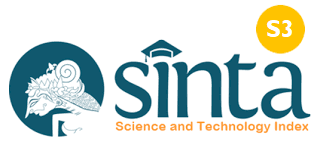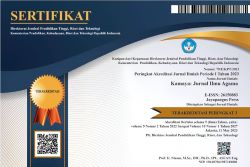Kepemimpinan Hindu Dalam Membangun Manusia Seutuhnya
DOI:
https://doi.org/10.37329/kamaya.v5i3.1995Keywords:
Hindu Leadership, Whole Man, Nitisastra, DharmaAbstract
Humans outwardly continue to develop and this development does not only cause positive impacts but also negative impacts accompanying human life individually and socially. Humans are naturally a leader for themselves and other individuals, but not all humans are aware of this, of course we need a concept or the right footing, in order to awaken the spirit of leadership in oneself as a whole human being based on dharma. The purpose of this research is to know and be able to apply the concept and contextual Hindu leadership in building a whole person. This research uses the research method of Library Research, which is qualitative in nature, with two data analysis strategies, namely the qualitative descriptive analysis strategy model and the verification analysis strategy. The development of Hindu leadership science is broadly sourced from Nitisastra as a leadership science. Nitisastra emphasizes the purpose of human life to improve balanced physical and spiritual well-being in the life of a whole person. In addition to Nitisastra, there is literature containing values and leadership teachings known as Geguritan Niti Raja Sasana. Whole human beings based on Hindu leadership apply the concept of Asta Brata which is the eight basic mental attitude for a leader in carrying out the dharma of religion and the dharma of the state. The conclusion from the results of this study is that as a human being, it is necessary to understand the teachings of Hindu leadership that have been contained in the nitisastra and geguritan niti raja sesana literature by applying the Hindu leadership concept in everyday life in order to build a complete human being that is relevant to the goals of Hinduism. namely to achieve Jagadhita and Moksha.
References
Adiputra, D. I. (2004). Dasar-Dasar Agama Hindu. Jakarta: Departemen Agama RI.
Anand, S. (2002). The Essence of the Hindu Religion. New Delhi: Rajkamal Electric Press.
Asyhadie, S. M. (2019). Pengantar Ilmu Hukum. Denpasar: Rajawali Pers.
Bose, A. (2000). Panggilan Veda. Surabaya: Paramita.
Bungin, B. (2003). Analisis Data Penelitian Kualitatif Pemahaman Filosofis Dan Metodelogis Ke Arah Penguasaan Model Aplikasi. Jakarta: PT . Raja Grafindo Persada.
Carnegie, D. (1993). Bagaimana Mencari Kawan Dan Mempengaruhi Orang Lain. Surabaya: Binarupa Aksara.
Daradjat, D. Z. (1980). Kesehatan Mental. Jakarta: PT. Gunung Agung.
Gazali, M. P. (1980). Ilmu Jiwa. Bandung: Ganaco N.V.
Kajeng, I. N. (1999). Sarasamuccaya. Surabaya: Paramitha.
Komang, S. (2018). Pura Kehen Bersatu Krama Bangli. Diterbitkan Dalam Rangka Karya Agung Panca Wali Krama dan Pengusabaan Ida Bhatara Turun Kabeh Pura Kehen Bangli.
Mantra, D. I. (2001). Bhagawadgita. Milik Pemerintah Provisni Bali.
Medera, N. (1997). Kakawin dan Mabebasan di Bali. Denpasar: Upada Sastra.
Mishra, P. (2008). Hindu Dharma Jalan Kehidupan Universal. Surabaya: Paramita.
Mulyono, I. S. (1979). Wayang dan karakter Manusia. Jakarta: Balai Pustaka.
Pasek, K. d. (1982). Niti Sastra. Proyek Pembinaan Mutu Pendidikan Agama Hindu dan Budha Departemen Agama RI.
Piliang, Y. A. (2006). Dunia yang Dilipat Tamasya Melampaui Batas-Batas Kebudayaan. Yogyakarta: Jalasutra.
Poerbotjoroko, P. D. (1982). Arti Ramayana. Denpasar: Institut Hindu Dharma Denpasar.
Pudja, G. &. (2003). Manawa Dharmasastra. Jakarta: Nitra Kencana Buana.
Pudja, G. (1999). Bhagawad Gita. Surabaya: Paramitha.
Punyatmadja, D. I. (1993). Dharma Sastra. Jakarta: Yayasan Dhrama Sarathi.
Putra, M. D. (2014). Swastikarana Pedoman Ajaran Hindu Dharma. Denpasar: Parisada Hindu Dharma Indonesia.
Putrawan, N. (2011). Pilar Yang Rapuh Bali Yang Runtuh. Denpasar: PT. Pustaka Manikgeni.
Sandi, B. G. (1981). Brahmanda Purana. Jakarta: Departemen Agama RI.
Schwartz, D. J. (1992). Berpikir dan Berjiwa Besar. Surabaya: Binarupa Aksara.
Sudarta, M. P. (2001). Arti Dan Fungsi Sarana Upakara. Milik Pemerintah Provinsi Bali.
Sudharta, T. (2004). Slokantara. Surabaya: Paramita.
Surakhmand, W. T. (1978). Paper, Skripsi, Tesis, Diskripsi. Bandung.
Titib, I. M. (1996). Veda Sabda Suci Pedoman Praktis Kehidupan. Surabaya: Paramita .
Titib, I. M. (2008). Wiracarita Itihasa. Surabaya: Paramita.
Warsika, M. I. (1986). Kertha Gosa Selayang Pandang. 1986.
Wiana, I. K. (2007). Tri Hita Karana Menurut Konsep Hindu. Surabaya: Paramita.
Wiana, M. ,. (2007). Tri Hita Karana Menurut Konsep Hindu. Surabaya: Paramita.
Windia, W. (1995). Menjawab Masalah Hukum. Denpasar: PT. BP Denpasar.
Zoetmulder, P. (2007). Kamus Jawa Kuna Indonesia. Jakarta: Gramedia Pustaka Utama.
Downloads
Published
How to Cite
Issue
Section
License
Copyright (c) 2022 Kamaya: Jurnal Ilmu Agama

This work is licensed under a Creative Commons Attribution-ShareAlike 4.0 International License.
An author who publishes in the Kamaya : Jurnal Ilmu Agama agrees to the following terms:
- Author retains the copyright and grants the journal the right of first publication of the work simultaneously licensed under the Creative Commons Attribution-ShareAlike 4.0 License that allows others to share the work with an acknowledgement of the work's authorship and initial publication in this journal
- Author is able to enter into separate, additional contractual arrangements for the non-exclusive distribution of the journal's published version of the work (e.g., post it to an institutional repository or publish it in a book) with the acknowledgement of its initial publication in this journal.
- Author is permitted and encouraged to post his/her work online (e.g., in institutional repositories or on their website) prior to and during the submission process, as it can lead to productive exchanges, as well as earlier and greater citation of the published work (See The Effect of Open Access).
Read more about the Creative Commons Attribution-ShareAlike 4.0 Licence here: https://creativecommons.org/licenses/by-sa/4.0/.





